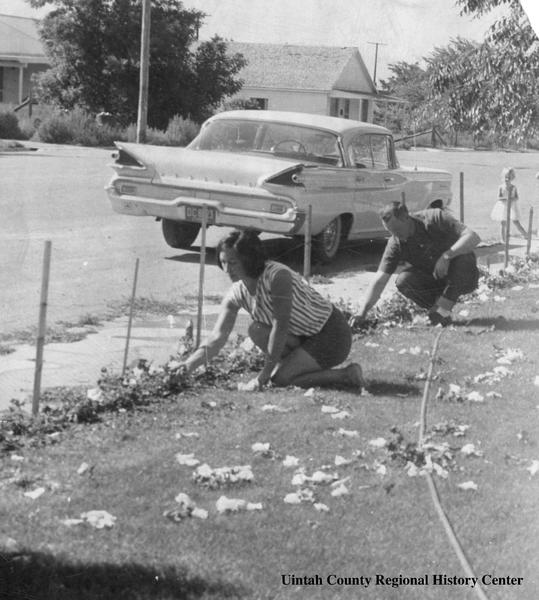Dublin Core
Title
Description
Utahns love their front lawns. When Mormon settlers moved West, they wanted to recreate the homes they left back East, including their grassy yards. This idea of “beauty equals green” persisted into the 20th Century, as the manicured lawn came to symbolize middle class prosperity and good hygiene. But, the lush landscaping of the East was difficult to replicate in Utah’s arid climate and homeowners used water excessively for sprinkling grass.
In 1914, Utah towns participated in the first statewide “Clean Town Contest.” Hosted by the Utah Development League and the State Board of Health, fifty-three towns entered the contest to improve the state’s sanitary conditions. Citizens cleared public roads and made general improvements to public facilities, and towns were graded on their grassy lawns and gardens. This early contest signaled the importance of appearances when it came to Utah’s front yards.
After World War II, families flocked to the suburbs where neatly manicured lawns symbolized postwar prosperity and neighborhood safety. City codes required lawns to be an appropriate length and free of weeds. Homeowners who did not comply could be reported for ordinance violations. Excessive water use was justified to maintain property values and the status quo. City councils struggled to accommodate the demand for yard water through years of drought and counties imposed watering hours to help curb usage. But, community attitudes toward lawns continued to take priority over water conservation.
Throughout later decades of the 20th Century, members of Salt Lake’s Planning and Zoning Committee revealed a distinct class divide in their approach to neighborhood cleanup. Izzi Wagner, a longtime member of the Committee, saw dandelions and weeds as an indictment of the entire West side of Salt Lake City. Wagner asserted, “If I had it my way I’d have a law and enforce it, I’d have a law that you can’t live in a home unless you take care of your lawn.”
Times change, however, and new city ordinances encourage water-wise plants. In fact, these days you may find more homeowners in your neighborhood trying to keep up with the Joneses by carefully xeriscaping their front yards with drought-tolerant plants.
Creator
Source
_______________
See John W. Caughey, “Toward an Understanding of the West,” Utah Historical Quarterly 27, no. 1 (1959): 1959): 17; Martha Sonntag Bradley, “A Postwar Movement into Better Times” in A History of Beaver County (Salt Lake City, UT: Utah State Historical Society, 1999): 298-373; Krystal D’Costa, “The American Obsession with Lawns,” The Scientific American, May 3, 2017; “The Nation’s First Statewide Clean Town Contest,” The History Blazer, January 1999; IJ “Izzie” Wagner, Transcript of an oral history conducted 1983 by Leslie Kelen, in Interviews with Jews in Utah Oral History Project at University of Utah, 1982-1988, Special Collections, J. Willard Marriott Library, University of Utah, pp. 190; Salt Lake City & American Legal Publishing Corporation, “UT Code of Ordinances: 21A.48.050: Design Standards and Guidelines,” (Cincinnati, OH: Sterling Codifiers, 2020).

